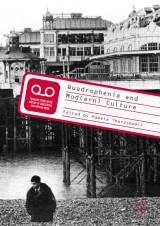Details

Quadrophenia and Mod(ern) Culture
Palgrave Studies in the History of Subcultures and Popular Music
|
128,39 € |
|
| Verlag: | Palgrave Macmillan |
| Format: | |
| Veröffentl.: | 07.11.2017 |
| ISBN/EAN: | 9783319647531 |
| Sprache: | englisch |
Dieses eBook enthält ein Wasserzeichen.
Beschreibungen
This collection explores the centrality of The Who’s classic album, and Franc Roddam’s cult classic film of adolescent life, <i>Quadrophenia</i> to the recent cultural history of Britain, to British subcultural studies, and to a continuing fascination with Mod style and culture. The interdisciplinary chapters collected here set the album and film amongst critical contexts including gender and sexuality studies, class analysis, and the film and album’s urban geographies, seeing <i>Quadrophenia</i> as a transatlantic phenomenon and as a perennial adolescent story. Contributors view Quadrophenia through a variety of lenses, including the Who’s history and reception, the 1970s English political and social landscape, the adolescent novel of development (the <i>bildungsroman</i>), the perception of the film through the eyes of Mods and Mod revivalists, 1970s socialist politics, punk, glam, sharp suits, scooters and the Brighton train, arguing for the continuing richness of <i>Quadrophenia’s</i>depiction of the adolescent dilemma. The volume includes new interviews with Franc Roddam, director of Quadrophenia, and the photographer Ethan Russell, who took the photos for the album’s famous photo booklet.<br><div><br></div>
1. Introduction: “Dressed Right for a Beach Fight”; Pamela Thurschwell.- Part One: <i>Quadrophenia </i>in its Histories.- 2. Brighton Rocked: Youth, Politics and Social Change During the Early 1960s; Bill Osgerby.- 3. ‘Who (the Fuck) are You?’ Out with the In Crowd in Quadrophenia (1973); Ben Winsworth.- 4. Discovering the Who’s Mod Past: The American Reception of Quadrophenia; Christine Feldman-Barrett.- 5. Heat Wave: The Who, the Mods and the Cultural Turn; Sam Cooper.- Part Two: The Mobility of Mod: Class, Culture and Identity.- 6. Class, Youth and Dirty Jobs: The working-class and post-war Britain in Pete Townshend’s Quadrophenia; Keith Gildart.- 7. Quad to Run: the crucible of identity as represented in Quadrophenia (1973) and Born to Run (1975); Suzanne Coker.- 8. Taking the 5:15: Mods, Social Mobility and the Railway; Tom F. Wright.- Part Three: Reading <i>Quadrophenia</i>: Genre, Gender, Sexuality.- 9. “What are you gonna do tonight? Wait for a phone call I suppose”: Girls, Mod Subculture, and reactions to the film Quadrophenia; Rosalind Watkiss Singelton.- 10. “Poofs wear lacquer, don’t they, eh?”: Quadrophenia and the Queerness of Mod Culture; Peter Hughes Jachimiak.- 11. The Drowning Machine: the sea and the scooter in Quadrophenia; Brian Baker.- 12. ‘“You were under the impression, that when you were walking forwards, that you’d end up further onwards, but things ain’t quite that simple”: Time Travelling and Quadrophenia’s segues; Pamela Thurschwell.- 13. Interview with Franc Roddam.- 14. Interview with Ethan Russell.- Index.
Pamela Thurschwell is Reader in English Literature at the University of Sussex, UK. Her publications include <i>Literature, Technology and Magical Thinking, 1880–1920</i> (2001) and <i>Sigmund Freud</i> (2000). She has also published widely on pop music, including essays on Billy Bragg, Bob Dylan, and Elvis Costello. She is currently writing a book on the temporality of adolescence in twentieth century.
This collection explores the centrality of The Who’s classic album, and Franc Roddam’s cult classic film of adolescent life, <i>Quadrophenia</i> to the recent cultural history of Britain, to British subcultural studies, and to a continuing fascination with Mod style and culture. The interdisciplinary chapters collected here set the album and film amongst critical contexts including gender and sexuality studies, class analysis, and the film and album’s urban geographies, seeing <i>Quadrophenia</i> as a transatlantic phenomenon and as a perennial adolescent story. Contributors view <i>Quadrophenia</i> through a variety of lenses, including the Who’s history and reception, the 1970s English political and social landscape, the adolescent novel of development (the <i>bildungsroman</i>), the perception of the film through the eyes of Mods and Mod revivalists, 1970s socialist politics, punk, glam, sharp suits, scooters and the Brighton train, arguing for thecontinuing richness of <i>Quadrophenia</i>’s depiction of the adolescent dilemma. The volume includes new interviews with Franc Roddam, director of <i>Quadrophenia</i>, and the photographer Ethan Russell, who took the photos for the album’s famous photo booklet.
Explores the importance of Quadrophenia to British cultural history and subcultural studies from the 1970s onwards Examines the interaction of Quadrophenia with class, culture, identity, genre, gender and sexuality Contains interviews with Frank Roddam, film director, and Ethan Russell, photographer Includes supplementary material: sn.pub/extras
Explores the importance of <i>Quadrophenia </i>to British cultural history and subcultural studies from the 1970s onwards<div>Examines the interaction of <i>Quadrophenia </i>with class, culture, identity, genre, gender and sexuality</div><div><div>Contains interviews with Frank Roddam, film director, and Ethan Russell, photographer<br></div><div><br></div></div>
Diese Produkte könnten Sie auch interessieren:

The Last Samurai - Japanische Geschichtsdarstellung im populären Kinofilm

von: Daniel Scherrer

34,99 €















